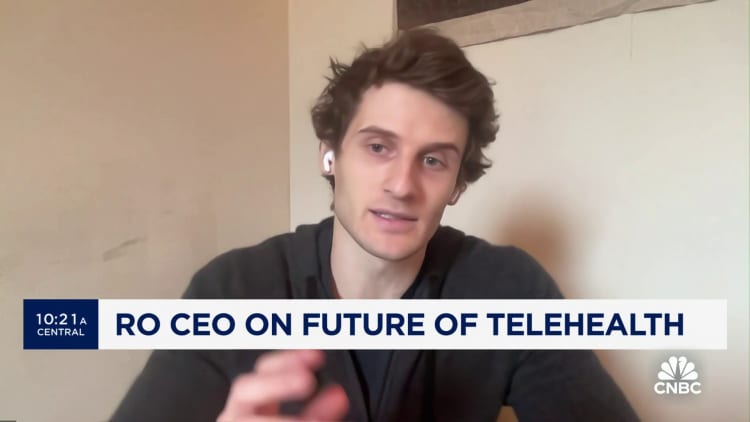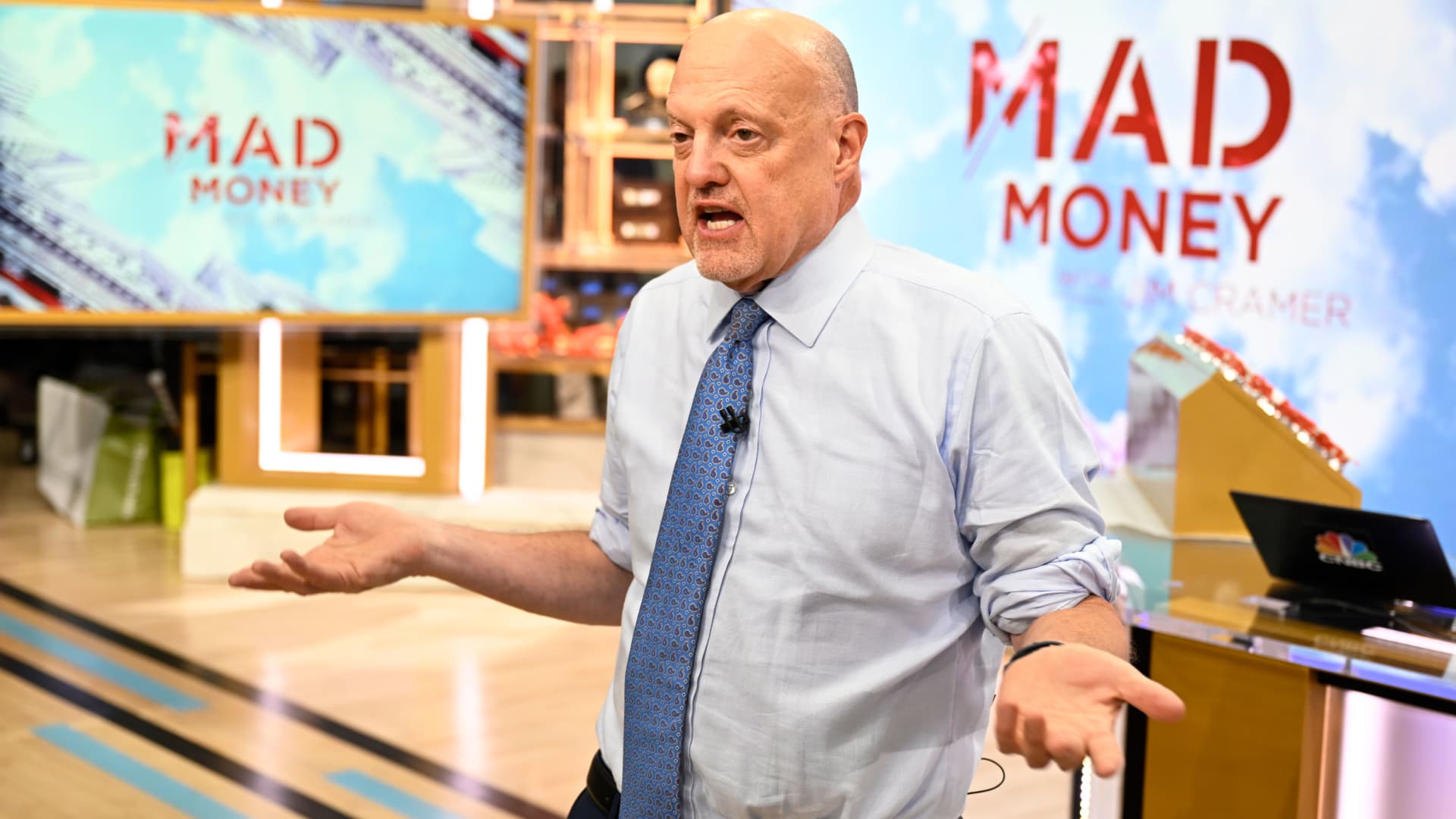How digital health companies are capitalizing on the GLP-1 boom
Joining the market for GLP-1s is a massive opportunity, and digital health companies from Ro to WeightWatchers are battling for market share.

Patent protection for Wegovy — Novo Nordisk's blockbuster weight loss drug, which contains the second generation GLP-1 active ingredient and is at least twice as effective — is expected to expire by the decade's end.
Michael Siluk | UCG | Getty Images
For Gray Beard, a kindergarten teacher in Charlotte, North Carolina, losing weight had become a grueling task. She'd tried five different programs in her life and never found lasting results.
Her luck started to change last year, when she saw a promotion on Instagram for the Ro Body Program, a new offering from online health startup Ro. The ad said eligible patients could get prescribed GLP-1s, the buzzy class of obesity treatments that's turned into a booming business in recent years.
Beard, 47, had previously sought a GLP-1 prescription, but her doctor "wouldn't even try" to get it approved, assuming her insurance company would reject coverage of the costly medication, she said. GLP-1s cost roughly $1,000 per month before insurance and other rebates.
Customers of Ro's Body Program could get prescribed a GLP-1, such as Novo Nordisk 's weight loss drug Wegovy or diabetes treatment Ozempic, and meet monthly with a doctor. They also get access to an educational curriculum, 24/7 messaging, one-on-one coaching with nurses and assistance with navigating insurance complexities.
Beard was 210 pounds when she first started the program early last year. She's since lost 40 pounds and serves as an ambassador for Ro. She pays $30 per month for the GLP-1 treatment, after insurance coverage, along with a $145 monthly fee for the program. And she has no plans to leave.
"I'm fine if I have to stay on it forever," Beard told CNBC.
Ro, founded as Roman in 2017, is part of a growing crop of digital health companies aiming to capitalize on the soaring demand for GLP-1s by building programs and services for users on top of the medications. The opportunity could be massive. Goldman Sachs analysts expect 15 million U.S. adults to be on anti-obesity drugs by 2030, and predict the industry could reach $100 billion in annual revenue by that time.
In addition to Wegovy and Ozempic, the GLP-1 class includes Eli Lilly's highly popular weight loss drug Zepbound and diabetes treatment Mounjaro. GLP-1s mimic a hormone produced in the gut to suppress a person's appetite and regulate blood sugar.
Like Ro, other non-drugmakers, including Calibrate, Sesame, Omada Health, Noom, Hims & Hers and even telehealth industry veterans Teladoc Health and WeightWatchers, have rolled out offerings geared toward patients on GLP-1s, or have expanded their services to include the popular medications.
Meanwhile, investors are cheering them on.
Shares of Ro competitor Hims & Hers popped 28% on May 20 after the company said it's now offering compounded GLP-1 injections in addition to its oral medication kits. CEO Andrew Dudum told CNBC the company is confident customers will be able to access a consistent supply of the injections.

Supply shortages are one of the big hurdles for companies in the market, as spiking demand has made it difficult for many patients to access the treatments. There's also been a rise of counterfeit products, according to the World Health Organization, which said in January that the combination of shortages and the "increased circulation of falsified versions" is particularly problematic for patients with Type 2 diabetes who count on the medication for disease management.
That's not slowing down industry executives like Ro founder Zachariah Reitano.
Ro didn't start out as a company focused on weight loss. Reitano launched it to sell treatments online for erectile dysfunction before moving on to hair loss and other pathologies.
In 2020, Ro switched to obesity management and, after Wegovy was approved by the Food and Drug Adminstration the following year, Reitano said patient inquiries started pouring in by the "tens of thousands."
Now, Ro is shoveling marketing dollars into its GLP-1 program — from digital ads, TV commercials and posters lining subway stations, to influencer campaigns featuring patients such as Beard.
Reitano told CNBC that GLP-1s are like a "jetpack for positive behavior change." Patients tend to exercise more, eat healthier and see around a 30% reduction in calorie intake, he said.
"Once you get a little bit of momentum, once you lose a little bit of weight, you're sleeping better, you have more energy, you can go to the gym, you can eat better and then that's that positive flywheel," Reitano said.
Ro has raised around $1 billion in funding to date, according to PitchBook. The company was valued at about $7 billion as of early 2022, though that was before a steep drop in tech stocks and collapse in the initial public offering market forced many startups to dramatically lower their valuations.
WeightWatchers joins the market
WeightWatchers has been in business for over 60 years and is the name in the U.S. perhaps most synonymous with weight loss programs.
In December, the company entered the GLP-1 market, with a behavioral-support program that's available through its general membership subscription, starting at $23 per month. Members can participate whether they get a GLP-1 prescription through their primary care physician or through the new WeightWatchers Clinic, introduced alongside the behavioral program.
Because GLP-1s suppress appetites, WeightWatchers quickly learned that it needed an entirely new program for people taking the meds, said Gary Foster, the company's chief scientific officer.
"They don't need help with what to do for dessert or how to deal with the bread on the table at a restaurant," Foster said in an interview. "That's like 50-60% of what we would do for people without meds."
Clinic members who participate in the GLP-1 program have to pay an additional fee — starting at $99 a month — for exclusive access to registered dieticians, fitness professionals and care team coordinators.
WeightWatchers said in its first-quarter results earlier this month that 87,000 people had subscribed to the clinic, although not all of them are taking GLP-1s. The company expects to have between 140,000 and 160,000 clinic subscribers by year-end, the report said.
It hasn't been enough to change WeightWatchers' trajectory. The stock has plummeted 83% this year on concerns about the company's debt load, its core weight loss business and Oprah Winfrey's announced departure from the board in February.
With respect to GLP-1s and their impact on weight loss, "the landscape is quite exciting," Foster said. "I think we should all celebrate and really be delighted by the fact that there are more tools in the toolbox to help people trying to manage their weight."
Kim Gradwell with an Ozempic injection needle at her home in Dudley, North Tyneside, Britain, October 31, 2023.
Lee Smith | Reuters
Jennifer VanGilder, a 51-year-old economics professor at Ursinus College in Collegeville, Pennsylvania, said she'd tried countless methods to lose weight, from strict diets to services like the defunct Jenny Craig. She was considering bariatric surgery before she came across a program from digital health startup Calibrate.
Calibrate, founded in 2019, was one of the first companies to treat obesity by combining GLP-1s with one-on-one coaching. The program costs $199 a month, which doesn't include the medication, and requires an initial three-month-long commitment.
VanGilder signed up nearly four years ago and started taking the weekly diabetes injection Ozempic specifically for weight loss. She later switched to Wegovy.
VanGilder said GLP-1s aren't a miracle drug, but by taking them and putting in the work, she said she lost around 100 pounds of her 242-pound weight. The big difference between Calibrate and prior weight loss efforts, VanGilder said, is that she doesn't feel like she's dieting.
"That's why I've been able to stay on it for as long as I have," VanGilder said.
Calibrate is one of the only companies to regularly release reports detailing the results of its weight loss program. The company's 2024 report examined data from roughly 16,000 members who completed at least one year of the program as of October, along with a smaller group of patients who continued for longer.
Average weight loss among patients was 16.2% at 12 months in the program, 17.3% at 18 months and 17.9% at 24 months, according to the report.
"Our data of proven outcomes shows that we can deliver faster, better results than some of the leading GLP-1 clinical trials," said Dr. Kristin Baier, Calibrate's vice president of clinical development, in an interview.
But Calibrate has hit some major speed bumps in the past couple years.
After raising $100 million in venture funding during the peak of the tech market in 2021, the combination of supply shortages, insurance challenges and the broader market swoon forced the startup to lay off hundreds of employees between 2022 and 2023. The company was acquired in October at a discount by private equity firm Madryn Asset Management.
Calibrate CEO Rob MacNaughton said the sector was "ill equipped" to manage the "dramatic demand that led to, at some point, severely, severely constrained supply" of GLP-1s last year.
Under new ownership, the company continues to promote its GLP-1 service, which its said is important because the drugs themselves aren't sufficient.
"GLP-1 medications, while they are safe and effective, they are a tool," said Baier. "They are not the entire treatment."
Options for patients
Ro's Reitano said shortages of Wegovy and other GLP-1s last year prompted his company to temporarily pause advertising. Ro also dolled out refunds and credits to patients in its program who weren't able to pick up their medication within 30 days of receiving a prescription, he said.
Reitano said Ro has built up "both technical tools and operations" to help patients navigate supply issues. That includes transferring prescriptions to different pharmacies based on their GLP-1 supply and proximity to a patient. From July to August, the company made 50,000 phone calls to pharmacies across the U.S. to coordinate those transfers, Reitano said.
Ro has also expanded its medication offerings, adding Zepbound following its U.S. approval in November.
"We added that to our formulary, and that's really when we started advertising again because we had confidence that we'd be able to get patients an option," Reitano said.

Insurance problems persist, though.
Some employers have dropped weight loss drugs from their plans due to the costs associated with covering the treatments for thousands of patients. The federal Medicare program by law can't cover weight loss drugs unless the prescription is for another approved health benefit, such as diabetes or cardiovascular health.
Eli Lilly and Novo Nordisk offer commercial savings card programs that aim to expand access to their GLP-1s. Eli Lilly allows people with insurance coverage for Zepbound to pay as low as $25 for a monthly prescription. And users who can't get insurance coverage, may be able to get the drug for as low as $550 a month.
The high costs and difficult access led Hims & Hers to initially stay out of the GLP-1 market even after launching its new weight loss program in December
Dr. Craig Primack, senior vice president of weight management at Hims, said the company decided to offer treatment regimens based on drugs that had been studied and prescribed for decades.
"We're going to have people, for one reason or another, who either don't want an injection at this point, or are just looking for a different alternative," Primack told CNBC in an interview in March. "These are tools we've been using in our field for a long, long time."
Last week, Hims said customers can now access compounded GLP-1 medications via a prescription from a licensed health-care provider on the platform. Hims said it plans to make branded GLP-1 medications available to its customers once supply is consistently available. The company's oral medication kits start at $79 a month, and its compounded GLP-1 injections will start at $199 a month.
Dudum said the company has partnered with one of the largest generic manufacturers in the U.S. and has a certain degree of exclusivity with the facility. The manufacturer has FDA oversight, he said.
Even before Hims introduced compounded GLP-1 injections to its weight loss offering, the company said it expects the program will generate more than $100 million in revenue by the end of 2025.
Beard, the Ro customer, has had to make some changes since starting the Body Program. She initially took Wegovy with no out-of-pocket costs, thanks to her insurance coverage and a savings card program from Novo Nordisk. But she hit a plateau on the drug, so she switched to Zepbound.
While there have been some hiccups along the way, Beard says the program has largely been a "seamless" addition to her day-to-day life, and that she no longer thinks about food all the time. She even got a family member to enroll.
"We're not having any bad side effects, so why go off of it?" she said, adding "it's helped both of us get to the weight we want."
Don’t miss these exclusives from CNBC PRO


 KickT
KickT 
































